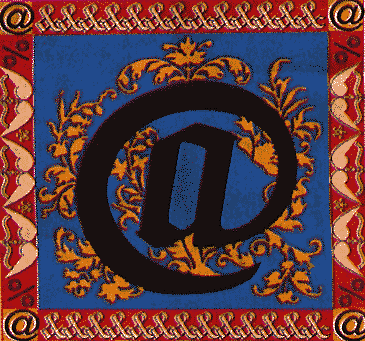a humble symbol @ first. but ligature now...


| At one time, the spiral symbol was little
more than a leftover from the dusty typewriter key-board. It enjoyed a
decent run on the comics pages, filling balloons with unprintable bursts
like "You no-good $#@ !" Many @ appearances were simply typos. But the
@ sign has gained a revival as the critical connector in e-mail addresses
and now has been elevated to a with-it symbol, an instant emblem of the
digital age.
As a catchy, high-tech slogan for their city, some Atlantans have proposed @lanta. As part of an exhibit on icons, the San Francisco Museum of Modern Art raved: "The @ is a condenser of the word 'at' that wraps its verv terseness around itself." Billionaire Bill Gates tossed it into the title of his best-selling book "Business @ the Speed of Thought." Colorful names are circling the globe. In South Africa the @ sign is referred to as a monkey's tail. In Italy some call it a snail. In China, little mouse. Elsewhere, it has been named everything from an elephant's trunk to a strudel. In the United States, where its flunky title is the "commercial at" sign, the curly character for a long time meant just that: at. As in, two apples @25¢ = 50¢. But why on earth did "at", a two-letter word, need to be abbreviated in the first place? And why did the coiled creature remain a fixture on the typewriter keyboard for decades after most people never used it? Answers to these and other imponderables require unravelling the fluky and resilient history of the @ sign,an epic that spans centuries, from parchment to the Internet. The curly symbol originated as a shortcut for medieval calligraphers, outlasting Latin, Old and Middle English, rolling right on through the printing press, the teletype and the typewriter. It might never have made it to the Age of the Internet but for a masterstroke one winter's day in 1971, in Cambridge, Massachusetts. There, in the offices of computer company Bolt, Beranek & Newman, a 30-year old programmer named Ray Tomlinson surveyed the keyboard on his Model-33 Teletype. A pioneer in the programming of e-mail, he was hunting for a single character to separate a name from a place so that computers routing messages wouldn't confuse the two. Mr Tomlinson is widely credited with being the first to press the "shift" and "2" keys together to launch the @ sign into cyberspace. He began by sending test messages back and forth in his office from one Digital PDP-10, a refrigerator-size computer, to another. His first-of-its-kind address: tomlinson@bbn-tenexa. "When you look at a keyboard, there aren't a whole lot of choices," says the 58-year-old Mr Tomlinson, playing down his symbolic achievement. "It pretty much jumped right out at me." Centuries earlier and an ocean away, the symbol got its start as a ligature, meaning two letters bound together, according to Berthold L. Ullman, a professor of Latin at the University of Chicago in his 1932 book "Ancient Writing and It's Influence". Parchment was scarce and precious, and European scribes devised numerous ligatures to save time and space. Toiling over texts, they often had to smash letters together—a and e, f and 1, t and h—particularly when they reached the end of lines. The @ sign abbreviated the Latin ad, a versatile little term meaning to, towards, near or at. A scribe would write the "a" and then merely curl the upstroke of the "d" around it, counter-clockwise. The @ sign probably surfaced in the Middle Ages, perhaps as an eighth century contemporary of the question mark. That would make the @ much older than symbols such as the £ sign or the apostrophe which made their marks in the 16th century. In the past few centuries the @ symbol mostly came to mean "price per unit", or the cost of individual goods on orders and bills. Just before the turn of this century boxy machines called type-writers had been having a hard time cracking the workplace. But in 1884, the @ symbol was affixed to the Caligraph No. 3 Commercial model. It spread to other models, and shortly thereafter, the typewriter took off. Over the years the little curlicue roamed the keyboard. On the Blickensderfer Electric model of 1902, the @ sign sat on the same key as the V. It hopped over to the Z key on the No. 12 Hammond in 1905. In Underwood models in the early 1920s the cent sign and the @ sign shared a key—which was supposed to be struck with the right pinkie. Early this century typists were taught by rote to use the @ sign. But by the time the United States mobilised for World War II, army clerks and secretarial pools had already begun shunning the little symbol. A 1942 manual called College Typing broke the news to the hunt-and-peck set as follows: "The use of the @ sign is decreasing. The unit prices are simply typed as decimal figures in the unit column of the invoice." Orphaned, the @ sign nonetheless endured on keyboards. Maybe that is because it is too intricate a character— impossible to improvise. In redesigns, typewriter manufacturers sometimes yanked other symbols from keyboards because typists learned to "construct" missing characters. Why, in some cases, was the ¢ sign pulled? A small "c" overtyped by the forward slash made a nifty replacement. Two hyphens — one made below the other by turning the roller —formed a makeshift equal sign. Whatever the case, the @ sign clung to the keys long enough for Mr Tomlinson, the computer pioneer, to punch it into the digital age. - taken from The Wall Street Journal – Dec ‘99. |